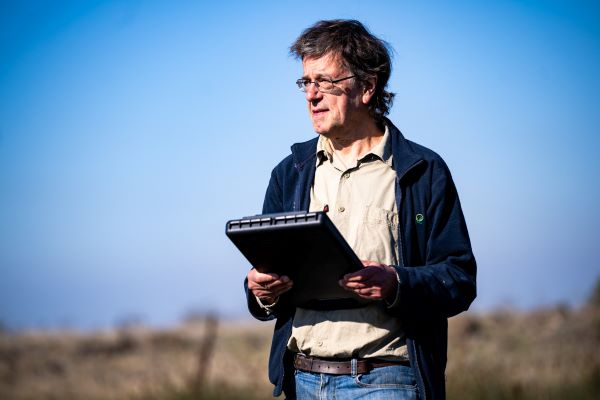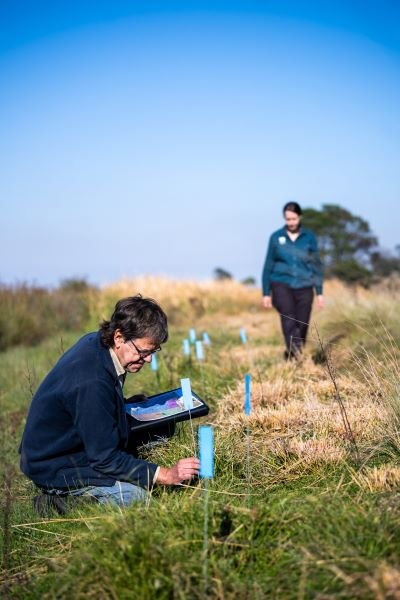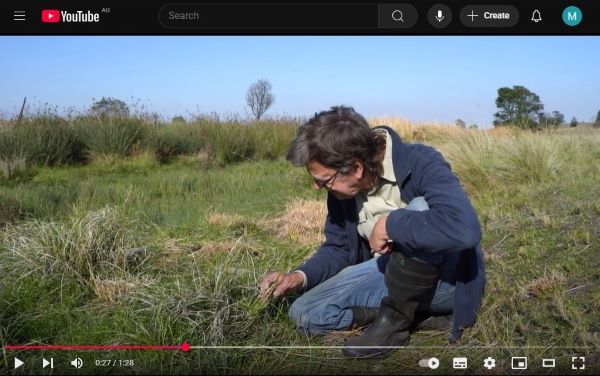As a child, Doug Frood was, in his own words, “that weird kid” – the one who loved insects, rocks and birds, and spent as much time as possible walking and camping in nature.
“Plants were my specialty,” he says. “Partly because I’m short-sighted and they don’t fly away like birds do. But also, I’ve just always had an affinity for them.”
That early passion for plants grew into a career as a botanical field ecologist. In the late 1980s and early 90s, Doug was working for the Victorian Government when he first spent time surveying grasslands along the Merri Creek.

“I was asked to assess the vegetation. So that meant quadrats, species lists, mapping... that kind of thing,” says Doug.
“When I got to Curly Sedge Creek, I found a site that was really quite complex geomorphologically, especially for the western plains – the escarpment, the stony knolls, the heavy soil plains, and the brackish wetland system. It had a lot of sheep grazing on it, and weed issues, but also significant native vegetation. I thought, this is interesting.”
Returning to Curly Sedge Creek
A few weeks ago, Doug returned to Curly Sedge Creek with a team from Merri Creek Management Committee and was surprised at what he found.
“I was expecting a desert. Last time I was there, visiting the site with some TAFE students, it was quite distressing to see it overgrazed and badly eroded. But this time, there was real potential.”
It’s that potential that MCMC is hoping to realise, with the help of our supporters in our annual campaign to protect Curly Sedge Creek.
“It’s still under pressure from weeds, but many threatened species are hanging on. The Brackish Plains Buttercup is prospering along the bank, the Curly Sedge is still doing well despite stormwater flows, and I’m told the Growling Grass Frogs are using the creek.”
With decades of experience in both wetland and grassland ecology, Doug is keen to emphasise that when it comes to land management, rehabilitation is often a more realistic approach than full restoration.
“It’s a process,” he explains. “You start from core areas containing key values and stabilise those before building outwards. Sometimes you’re able to improve a particular patch of vegetation; other times you’re maintaining what’s there and preventing further loss.”
To hear more from Doug, watch our video.
For this particular landscape, the next steps are clear: start with managing high-impact weeds like Spiny Rush and Lobed Needle-grass.
“MCMC are very well placed to do this work because they understand both the principles of ecological restoration, and the need for using multiple tools – whether that’s hand weeding or selective spraying. Further down the line there may be room for some creative thinking – assessing the effects of kangaroo grazing, or re-establishing some of the species that have been knocked out of there – but the immediate priority is the weed management.”
Intimate connections with place

For Doug, conservation work is grounded in long-term relationships – with both people and places. He recalls a remarkable period in his career that was spent mapping Barmah-Millewa Forest, Australia’s largest River Red-gum forest. “I ended up having to walk pretty much the entire forest, which is 30,000 hectares,” he says with a laugh.
“It was a once-in-a-lifetime chance to develop an intimate connection with a place, seeing it through wet and dry cycles, each time encountering different animals and insects. That was an extremely rich time of life for me.”
Increasing urbanisation has made it more challenging for today’s young people to experience the kind of childhood Doug enjoyed, with hours spent outside exploring the bush. He believes this has led to a growing disconnect with nature.
But, even so, Doug remains hopeful.
“You have to consider the resilience of life; there are still wild places in Australia where nature thrives. I also take heart from the many conservation and volunteer groups doing good work. Nature connection grows out of relationship – you have to spend time in a place. That’s how the ropes of connection form.”
Those connections have been redrawn at Curly Sedge Creek and galgi ngarrk, where Doug feels hopeful that community support could make a real difference.
“It would be great to see a thriving grassland that’s providing a refuge for some of these very special plants and animals,” he says. “Retaining what’s there, and making sure those significant values aren’t lost, is really important.”
Click here for more information about our project at Curly Sedge Creek.






 Merri Creek Management Committee. 2 Lee St, East Brunswick, Victoria, Australia 3057
Merri Creek Management Committee. 2 Lee St, East Brunswick, Victoria, Australia 3057